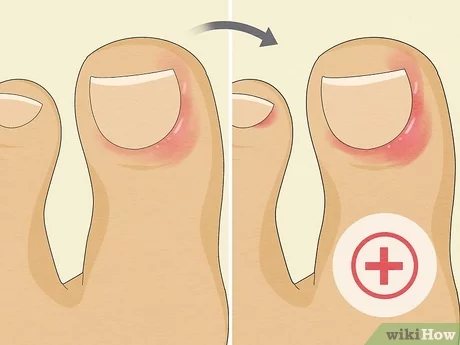Toenail fungus infections and paronychia are common but often misunderstood conditions that affect the nails, particularly the toenails. Toenail fungus, medically known as onychomycosis, is a fungal infection that can lead to discoloration, thickening, and crumbling of the toenail. Paronychia, on the other hand, is an infection of the skin around the nail, which may result from bacterial or fungal infections, causing pain, swelling, and redness. This article provides an in-depth overview of toenail fungus and paronychia, with a focus on treatment and management strategies.
1. Understanding Toenail Fungus Infection
Toenail fungus is a fungal infection that can affect the toenails and, in some cases, fingernails. It is primarily caused by dermatophytes, but yeasts and molds can also be responsible. The infection typically begins as a small, white or yellowish spot under the tip of the nail. As the infection progresses, the nail may become discolored, thickened, brittle, or even detach from the nail bed.
Causes of Toenail Fungus
Toenail fungus infections are caused by a variety of factors, including:
- Fungal spores: Fungi thrive in warm, moist environments, making areas such as public showers, swimming pools, and gyms ideal places for fungal spores to spread.
- Poor nail hygiene: Inadequate nail care, such as not trimming the nails properly or failing to keep the nails dry, can lead to fungal infections.
- Sweaty feet: Excessive sweating of the feet can create an environment conducive to fungal growth.
- Injuries: Minor injuries or trauma to the toenails, such as dropping something heavy on the toes or wearing tight shoes, can lead to infections by providing an entry point for fungi.
- Pre-existing health conditions: People with diabetes, circulatory problems, or weakened immune systems are more susceptible to fungal infections.
Symptoms of Toenail Fungus
Toenail fungus can present itself in a variety of ways. Common symptoms include:
- Discoloration: The nail may turn yellow, brown, or white.
- Thickened nails: The toenail may become thicker and more difficult to trim.
- Brittle or crumbly nails: The nail may become weak and break apart.
- Separation from the nail bed: In severe cases, the nail may detach from the nail bed, which can lead to pain and infection.
- Odor: A foul smell may emanate from the affected nail.
2. Understanding Paronychia
Paronychia is an infection of the skin around the nail. It can affect both fingernails and toenails, but it is more common in the hands. Paronychia is typically caused by bacteria or fungi, and it can occur as an acute or chronic condition.
Causes of Paronychia
The causes of paronychia can vary depending on whether the infection is bacterial or fungal:
- Bacterial Paronychia: The most common cause of bacterial paronychia is the bacterium Staphylococcus aureus. This type of infection is often the result of trauma, such as biting nails, hangnails, or cuticle injuries, which allows bacteria to enter the skin around the nail.
- Fungal Paronychia: Fungal paronychia, like toenail fungus, is usually caused by dermatophytes, yeasts, or molds. This type of infection is more common in people with compromised immune systems or who frequently expose their hands to moisture.
Symptoms of Paronychia
Paronychia can manifest as acute or chronic, depending on the duration of the infection:
- Acute Paronychia: This type of infection comes on suddenly and is characterized by:
- Redness and swelling around the nail.
- Pain and tenderness in the affected area.
- Pus or fluid collection near the base of the nail.
- The nail may appear discolored or misshapen.
- Chronic Paronychia: This condition develops over time and is characterized by:
- Recurrent swelling and redness around the nail.
- Thickened skin around the nail.
- White or yellowish discoloration of the nail.
- A history of repeated episodes of acute paronychia.
Diagnosis of Paronychia
A healthcare provider typically diagnoses paronychia through a physical examination of the affected area. In some cases, a sample of the fluid or pus from the infection site may be taken to identify the specific type of microorganism responsible for the infection. Fungal cultures or bacterial cultures may be ordered to guide treatment.
3. Paronychia Treatment & Management
The treatment and management of toenail fungus and paronychia can vary depending on the severity of the infection and whether it is caused by a fungus or bacteria. In many cases, early intervention can prevent complications and alleviate symptoms.
A. Treating Toenail Fungus
The treatment for toenail fungus typically involves a combination of antifungal medications, lifestyle changes, and preventive measures.
1. Antifungal Medications
Antifungal treatments for toenail fungus can be applied topically or taken orally, depending on the severity and extent of the infection.
- Topical antifungals: Creams, gels, or lacquers that are applied directly to the affected nail are available for mild to moderate infections. Common topical antifungals include ciclopirox (Penlac), efinaconazole (Jublia), and tavaborole (Kerydin).
- These medications work by penetrating the nail and killing the fungus beneath.
- Topical treatments may require several months of application, as toenails grow slowly.
- Oral antifungals: In more severe cases, oral antifungal medications may be prescribed. These medications include:
- Terbinafine (Lamisil)
- Itraconazole (Sporanox)
- Fluconazole (Diflucan)
- Oral antifungals are often more effective than topical treatments, but they may have potential side effects and may require liver function monitoring during treatment.
2. Laser Therapy
Laser treatment has emerged as a promising option for treating toenail fungus. The laser targets and kills the fungus under the nail without harming the surrounding tissue. This non-invasive treatment is typically used in conjunction with other therapies and can be effective for individuals who do not respond well to oral or topical antifungals.
3. Surgical Treatment
In rare cases, when toenail fungus is severe and persistent, surgical intervention may be necessary. This may involve the removal of the infected nail, allowing for new, healthy nail growth. However, this is typically considered a last resort.
4. Lifestyle Changes & Preventive Measures
To help prevent toenail fungus and reduce the risk of reinfection, consider the following:
- Keep your feet dry: Fungi thrive in moist environments, so it is essential to keep your feet dry, especially after swimming or showering.
- Practice good foot hygiene: Wash your feet regularly with soap and water, and ensure they are completely dry before putting on socks or shoes.
- Wear breathable footwear: Choose shoes made of materials that allow your feet to breathe, and avoid tight-fitting shoes that can cause excessive sweating.
- Avoid walking barefoot in public areas: Fungi can spread easily in public places like pools, locker rooms, and showers, so wearing sandals or flip-flops in these environments can help protect your feet.
- Trim your nails regularly: Keep toenails trimmed short and filed to prevent trauma that could make them more susceptible to infection.
B. Treating Paronychia
The treatment for paronychia depends on whether the infection is caused by bacteria or fungi. It may also vary based on whether the infection is acute or chronic.
1. Bacterial Paronychia Treatment
- Antibiotics: If the paronychia is caused by a bacterial infection, antibiotics may be prescribed. Oral antibiotics such as dicloxacillin or cephalexin may be used for mild infections, while more severe cases may require intravenous antibiotics.
- Drainage: In cases where there is significant pus or fluid accumulation, a healthcare provider may need to drain the infected area. This can provide relief from pressure and allow the infection to heal more effectively.
- Warm compresses: Applying warm, moist compresses to the infected area can help alleviate pain and promote drainage.
2. Fungal Paronychia Treatment
- Topical antifungal creams: If fungal paronychia is diagnosed, topical antifungal medications such as clotrimazole or terbinafine may be prescribed. These treatments are applied to the infected area and may be effective in mild cases.
- Oral antifungal medications: For chronic or severe fungal paronychia, oral antifungal drugs such as fluconazole or itraconazole may be recommended.
- Surgical intervention: In rare cases, when the infection does not respond to antifungal medications, the affected portion of the nail or the skin around the nail may need to be removed.
3. Preventing Paronychia Recurrence
To prevent future episodes of paronychia, follow these tips:
- Practice good hand hygiene: Keep your hands clean and avoid trauma to the skin around the nails.
- Avoid nail-biting and picking at cuticles: These behaviors can introduce bacteria or fungi into the skin around the nails.
- Protect your hands: If your hands are frequently exposed to water or chemicals, wear protective gloves to minimize irritation and infection risks.
4. Conclusion
Toenail fungus and paronychia are common nail infections that, if left untreated, can lead to significant discomfort and complications. Proper diagnosis, timely treatment, and adherence to preventive measures are essential for managing these conditions effectively. While toenail fungus often requires antifungal treatments and lifestyle modifications, paronychia may require antibiotics or antifungal medications depending on the underlying cause. In both cases, early intervention can help prevent the infections from becoming chronic or more severe. By taking steps to maintain proper foot and nail hygiene, individuals can reduce the risk of both toenail fungus and paronychia, promoting overall nail health.



